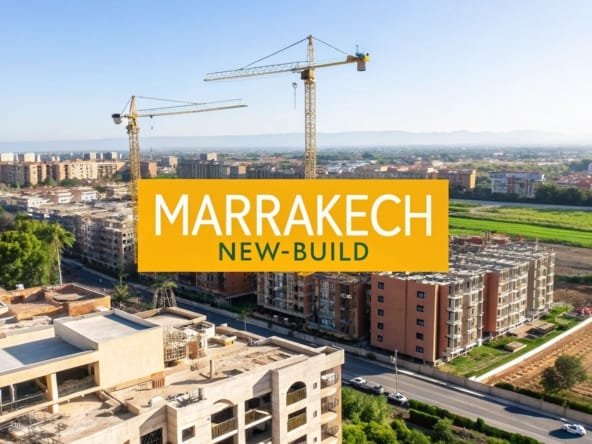Inside Marrakech's Thriving Property Market
Marrakech's real estate market offers a unique blend of historical charm and modern investment opportunities. The city's vibrant culture, stunning architecture, and growing tourism sector attract both local and international buyers. This surge in interest has created a dynamic market where traditional riads within the ancient Medina coexist with luxurious villas in the developing suburbs. This intriguing contrast contributes to the diverse investment landscape.
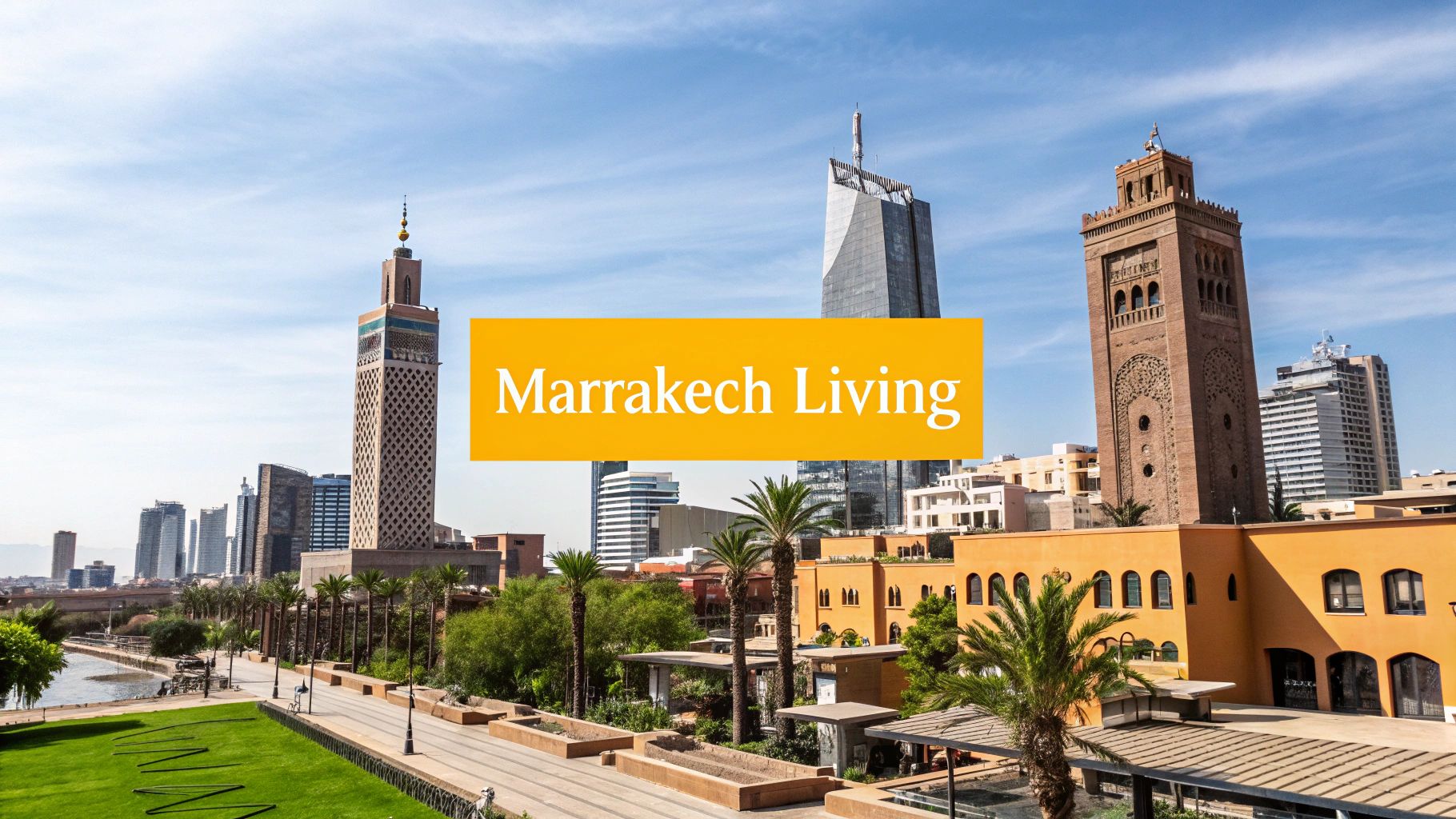
Key Drivers of Marrakech's Property Market
Several factors fuel Marrakech, Morocco's real estate growth. The city's rich history and cultural heritage are major draws. Properties like renovated riads offer a unique investment. Increased accessibility through international flights and improved infrastructure makes it easier for foreign investors to enter the market. Growth in tourism fuels demand for both short-term and long-term rentals, creating attractive income potential.
La Palmeraie, known for its luxury villas, benefits from increased tourism, while the Medina attracts buyers seeking traditional riads. Marrakech’s real estate market, particularly the luxury sector, is experiencing significant growth. By 2025, trends like foreign investment in high-end properties and the renovation of historic riads are expected to continue. These luxury properties are in high demand, often serving as second homes or tourist rentals. Explore this topic further here.
Investment Opportunities and Challenges
Marrakech's property market presents diverse opportunities. Investors can choose from various property types, including:
-
Traditional Riads: These historic homes, often located within the Medina, offer unique investment and strong rental potential. However, renovation can be complex and may require specialized knowledge.
-
Modern Apartments: These offer contemporary living and often include amenities. They attract young professionals and families.
-
Luxury Villas: Located in areas like La Palmeraie, these cater to affluent buyers and offer significant rental income, particularly within the luxury sector.
While the market offers promising opportunities, challenges exist. Navigating the legal complexities of Moroccan property transactions can be difficult for foreign investors. Understanding local regulations, securing clear title, and managing renovations are crucial for successful investment. Working with experienced local professionals, such as real estate agents and lawyers, is essential.
The Future of Real Estate in Marrakech
The future of Marrakech's real estate market appears promising. Continued investment in infrastructure and the city's growing reputation as a premier tourist destination are expected to drive further growth. However, factors like global economic trends and local regulations can influence market dynamics. Staying informed and adapting investment strategies are crucial for long-term success in this vibrant market. The diversity of property types and the city’s unique cultural appeal make Marrakech a compelling location for those seeking both a rewarding investment and a piece of Moroccan history.
Investing in Marrakech Real Estate: A Neighborhood Guide
Marrakech, a city of vibrant culture and rich history, presents a compelling opportunity for real estate investors. Beyond the bustling souks and stunning palaces, Marrakech's diverse neighborhoods offer unique investment prospects. Understanding the distinct characteristics of each area is crucial for maximizing returns in the "real estate Marrakech Morocco" market.
Exploring Marrakech's Prime Investment Areas
Established neighborhoods like Guéliz, known as the "new city," continue to attract investors with their blend of Art Deco architecture and modern developments. This area appeals to those seeking a contemporary lifestyle within easy reach of Marrakech's cultural heart. Hivernage, another sought-after locale, boasts luxury hotels, high-end boutiques, and a dynamic nightlife, making it a prime location for affluent buyers.
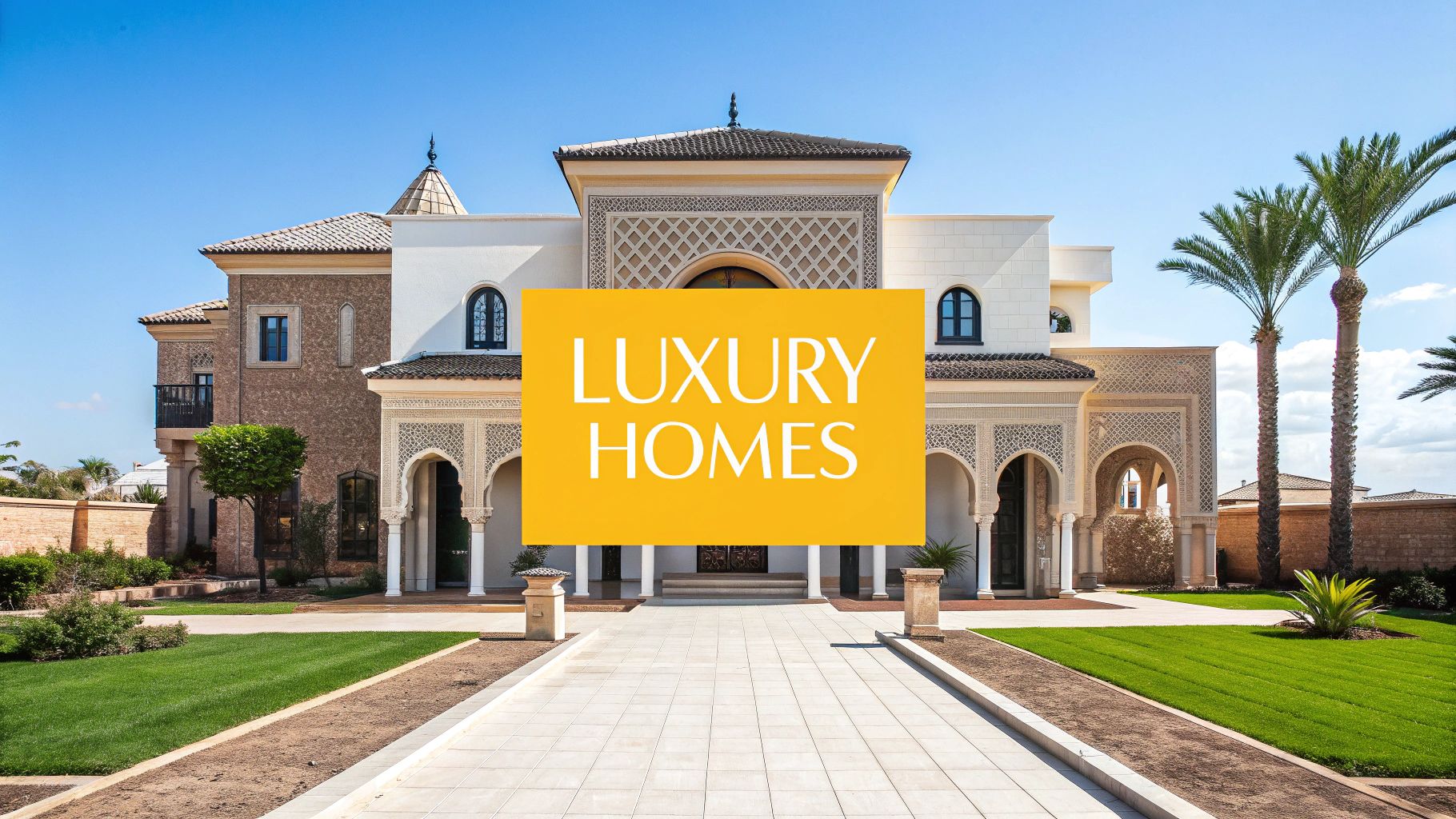
Emerging areas like M’Hamid are also gaining traction, offering a quieter retreat near the Palmeraie, Marrakech's iconic palm grove. This proximity to nature, combined with easy access to the city center, makes M’Hamid an attractive option for those seeking a balanced lifestyle.
For a detailed list of available properties, browse our property listings.
Property Types and Investment Strategies
The ideal property type varies significantly across Marrakech's neighborhoods. In the heart of the Medina, traditional riads present a unique investment opportunity. These beautifully restored homes, often featuring intricate Moroccan design elements, appeal to those seeking an authentic cultural experience. However, renovations can be complex, requiring careful planning and execution.
In areas like Amelkis and Targa, modern apartments and villas within gated communities are increasingly popular. These properties offer contemporary living with amenities like swimming pools and enhanced security, catering to a growing demand for modern lifestyles.
Factors Influencing Investment Potential
Several key factors contribute to a location's investment potential. Accessibility, particularly proximity to transportation networks and major roads, is crucial. Infrastructure development, including reliable utilities and modern amenities, significantly influences property values. Finally, proximity to key attractions, such as the Jemaa el-Fna square or renowned golf courses, drives both rental demand and long-term appreciation.
To help you compare the key investment areas, we’ve compiled the following table:
The table below, "Marrakech Neighborhood Comparison", provides a comprehensive overview of the main real estate investment areas in Marrakech, highlighting their key characteristics and property types. This comparison will assist you in identifying the location that best aligns with your investment objectives.
| Neighborhood | Property Types | Price Range | Key Features | Investment Potential |
|---|---|---|---|---|
| Guéliz | Apartments, Modern Villas | Mid-range to High-end | Modern amenities, Art Deco architecture | Strong growth potential, attracts younger demographics |
| Hivernage | Luxury Apartments, Villas, Hotels | High-end | Upscale living, vibrant nightlife | Established luxury market, stable returns |
| Medina | Riads, Traditional Homes | Varied, depending on renovation | Authentic charm, historical significance | Strong rental potential for renovated properties |
| Palmeraie | Luxury Villas, Resorts | High-end | Tranquil setting, proximity to palm grove | Exclusive market, high rental income potential |
| M’Hamid | Villas, Developing Projects | Mid-range to High-end | Emerging area, quieter lifestyle | High potential for future growth |
As this table illustrates, each neighborhood offers a distinct investment profile. Guéliz and M’Hamid present opportunities for growth, while Hivernage and Palmeraie cater to the luxury market. The Medina offers unique charm and strong rental potential, but requires careful consideration of renovation complexities.
For those seeking to explore specific property options within these neighborhoods, we invite you to visit our property listings. By carefully evaluating these factors, investors can navigate the Marrakech real estate market with confidence and identify the locations best suited to their individual investment goals.
Property Types That Win in Marrakech's Market
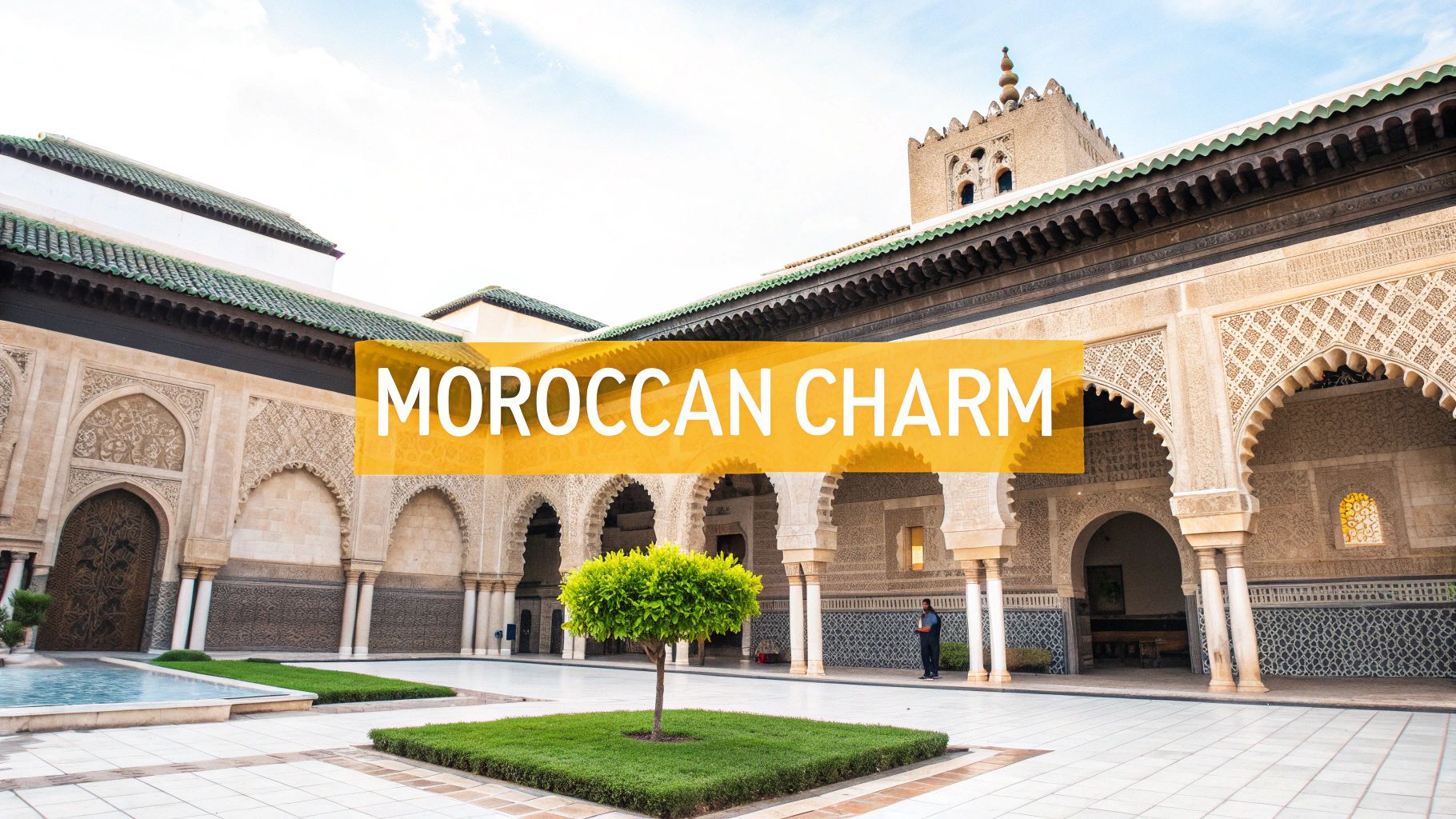
The Marrakech real estate market presents diverse opportunities, but not all properties perform equally. Strategic property selection is crucial for investment success in Marrakech, Morocco. This requires a deep understanding of individual property types and their alignment with current market demands. Let's explore the leading property types currently thriving in Marrakech.
Traditional Riads: Timeless Charm
Riads, the traditional Moroccan houses featuring interior courtyards, continue to attract both local and international buyers. Their distinct architectural charm and historical significance create a unique investment opportunity. Well-maintained and renovated riads, particularly those within the Medina, often command premium prices and generate substantial rental income through platforms like Airbnb.
However, renovating a riad can present challenges. Navigating local regulations and sourcing skilled artisans are essential for a successful restoration. Ongoing maintenance for these historic structures can be more demanding than for modern properties. Therefore, careful consideration of long-term upkeep costs is crucial.
Modern Apartments and Villas: Contemporary Living
The demand for modern apartments and villas is on the rise, fueled by younger professionals and families seeking contemporary living spaces. These properties, often located in planned communities, offer amenities such as swimming pools, gyms, and enhanced security.
This appeals to a market segment that prioritizes convenience and modern comfort. Areas like Amelkis and Targa are experiencing significant growth in this segment. Gated communities, for instance, offer a sense of exclusivity and security, highly valued by residents and investors. The availability of modern amenities enhances rental appeal and contributes to higher rental yields.
The Renovation Game: Profitable Potential
Renovating existing properties in Marrakech can be a lucrative investment strategy. This is especially true for properties with unique architectural features or prime locations. Modernizing traditional riads while preserving their historic character can significantly increase market value.
However, avoiding overspending on renovations that don't align with buyer preferences or local market trends is paramount. Balancing historical preservation with modern updates is key to maximizing return on investment. For further insights, explore different property types in Marrakech: Exploring Different Property Types in Marrakech.
Maintenance and Practical Considerations
In Marrakech's climate, practical considerations such as reliable water access and efficient climate control are vital for both comfort and long-term property value. Properties equipped with modern cooling systems and reliable water supply are highly attractive to buyers and renters.
Furthermore, sustainable features like solar panels are gaining popularity as environmental awareness grows among investors. Understanding the maintenance requirements of different property types is essential for informed decision-making. Factoring in costs associated with upkeep, repairs, and ongoing maintenance ensures sustainable profitability.
Economic Forces Shaping Real Estate in Marrakech, Morocco
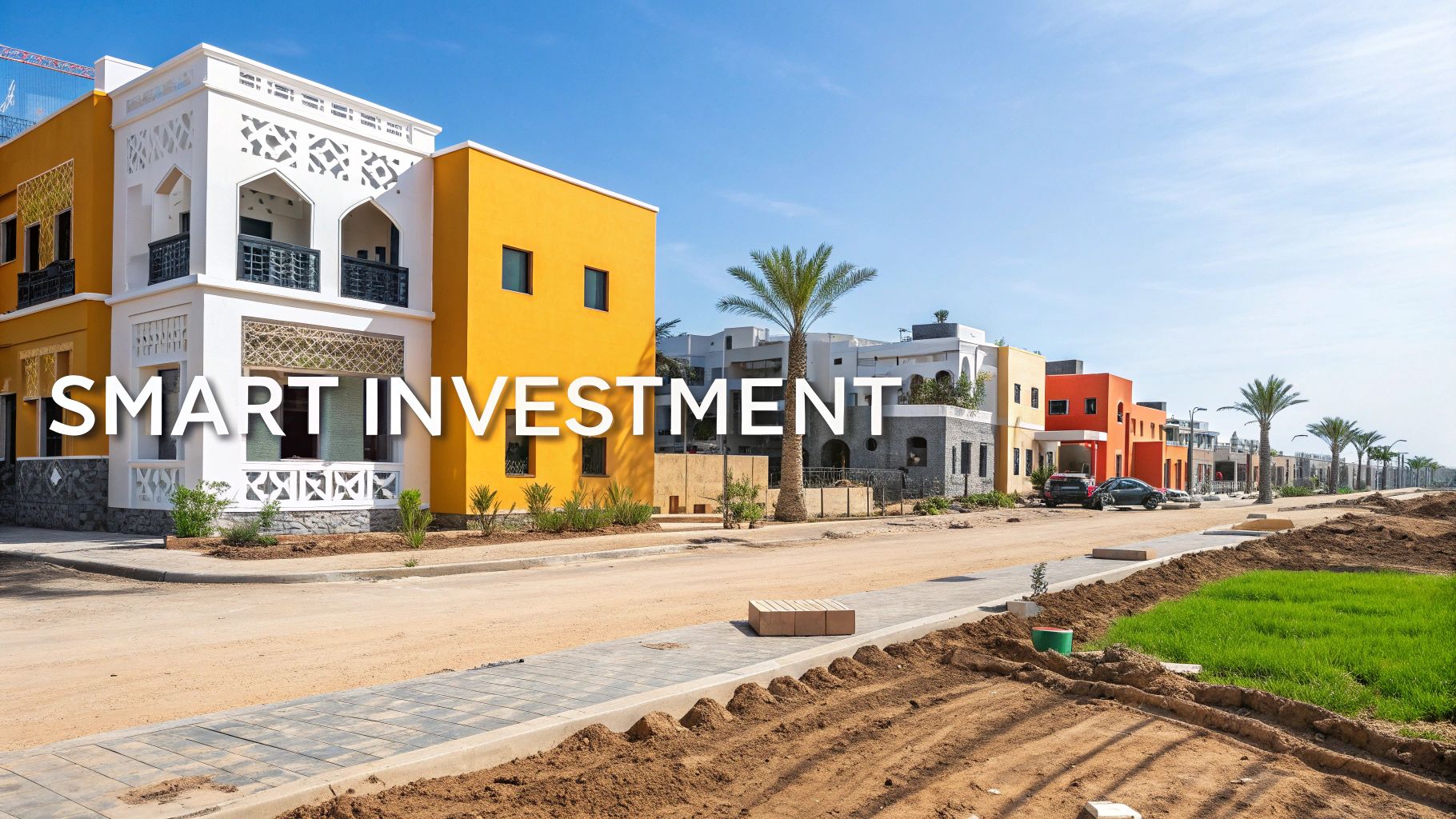
Understanding the economic forces influencing Marrakech is essential for informed real estate investment decisions. These forces, often subtle yet powerful, can significantly impact property values, rental yields, and overall market trends. Factors such as interest rate fluctuations, currency exchange rates, and government policies all contribute to shaping the Marrakech real estate market.
Macroeconomic Influences on the Marrakech Market
Morocco's overall economic health directly impacts its real estate sector. A strong economy typically drives demand for property, while economic downturns can lead to market stagnation or price adjustments. Key economic indicators like inflation and unemployment rates also influence market sentiment and investor confidence. These broader national trends set the context for understanding the specific market dynamics within Marrakech.
Historically, Morocco's real estate market has mirrored these larger economic trends. After experiencing a contraction in 2020 due to the COVID-19 pandemic, the Moroccan economy rebounded with 8% growth in 2021. However, this growth slowed to 1.3% in 2022 and stabilized around 3% in 2023. The International Monetary Fund (IMF) projects continued growth of 3.1% in 2024 and 3.3% in 2025. While this economic recovery has generally supported the real estate sector, residential property demand has been somewhat subdued, with transactions decreasing by 3.1% year-on-year in the first quarter of 2024. For more detailed market statistics, see Global Property Guide – Morocco Price History.
Currency Considerations for Foreign Investors
Foreign investors must carefully consider currency exchange rates and their potential effects on investment returns. Fluctuations in the value of the Moroccan Dirham relative to other currencies can influence both the initial investment cost and the final profit when selling a property. This introduces currency risk, requiring thorough analysis. For instance, a strengthening Dirham can decrease the return on investment for a foreign buyer when converting profits back to their home currency.
Government Policies and Their Impact on Real Estate
Government initiatives significantly shape real estate markets. Policies concerning infrastructure development, urban planning, and tax incentives can all influence property values in targeted areas. Staying informed about these initiatives and their potential impact is crucial for making sound investment decisions. This includes monitoring regulatory changes and anticipating their effects on specific neighborhoods and property types.
Analyzing Economic Indicators for Informed Decision-Making
The ability to interpret economic indicators and market data is crucial for effective investment timing. Recognizing market trends and anticipating future shifts can help investors seize opportunities and minimize potential risks. This involves understanding how different economic forces interact and influence the Marrakech real estate market. Careful data analysis and interpretation are essential for extracting meaningful insights to inform investment strategies. By combining an understanding of macroeconomic factors, currency dynamics, government policies, and current market trends, investors can position themselves for success in the Marrakech real estate market.
Sustainable Real Estate in Marrakech: A Blend of Tradition and Innovation
Marrakech's real estate market is witnessing a significant shift towards sustainability. Developers are now integrating eco-friendly practices with the rich heritage of Moroccan architecture, creating properties that are both luxurious and environmentally conscious. This movement is not just a fleeting trend, but a reflection of increasing environmental awareness and the growing demand for responsible living.
Blending Tradition with Modern Technology
Moroccan architecture has long emphasized harmony with the environment. Traditional techniques, such as using locally sourced materials and incorporating natural ventilation, are inherently sustainable. Developers are building on this foundation by incorporating modern technologies like solar panels and rainwater harvesting systems. This approach minimizes environmental impact while preserving the unique beauty of Moroccan design. For example, traditional courtyard gardens, a signature element of Moroccan architecture, are being reimagined as vibrant ecosystems that enhance biodiversity and mitigate urban heat.
Eco-Features: Separating Value from Marketing
It's important to distinguish between genuinely valuable eco-features and those used primarily for marketing. Solar water heaters, for example, provide substantial savings on energy bills, representing a clear return on investment. Similarly, high-performance insulation significantly reduces the need for heating and cooling, leading to lower energy consumption. However, features like low-flow showerheads, while environmentally beneficial, may not align with the luxury experience expected in high-end Marrakech properties. Discerning buyers recognize this distinction and seek properties with substantial sustainability benefits, not just superficial “greenwashing.”
The Rise of the Eco-Conscious Investor
The demand for sustainable properties is fueled by a growing number of environmentally conscious buyers and tenants, especially among European investors. These individuals prioritize eco-friendly features and are often willing to pay a premium for properties that reflect their values. This is creating a specialized niche within the Marrakech real estate market. Furthermore, the long-term advantages of sustainable properties, such as lower operating costs and increased resilience to climate change, are becoming increasingly attractive. This translates to higher resale values and a competitive advantage in the market. The real estate market in Marrakech is also influenced by overall trends in sustainability. As environmental awareness increases, buyers seek properties with green features like energy-efficient systems and sustainable materials. Many real estate projects, particularly in residential areas, now prioritize ecological criteria to meet this demand. This shift not only appeals to environmentally conscious buyers, but also enhances property values by reducing operational costs and environmental impact. Learn more about Marrakech real estate trends here.
Market Resilience and Performance
Sustainable properties in Marrakech are proving resilient against market fluctuations. During periods of economic uncertainty or seasonal shifts in demand, these properties tend to retain their value and attract a steady stream of tenants. This stability stems from the enduring appeal of eco-conscious living and the long-term cost savings associated with green features. Emerging case studies are demonstrating how these properties outperform traditional buildings in terms of both rental income and resale value, further reinforcing the benefits of investing in sustainable real estate in Marrakech.
Navigating The Legal Landscape of Marrakech Property Investments
Investing in Marrakech's vibrant real estate market offers exciting prospects. However, navigating the legal complexities is crucial for a secure and successful investment. Understanding Moroccan property law, including the purchase process and potential pitfalls, is essential for protecting your investment.
Freehold vs. Rights of Use: Defining Ownership
A fundamental legal distinction in Marrakech's real estate market is between freehold and rights of use. Freehold ownership grants you complete control over the property and the land it occupies, offering the highest level of security. Rights of use, on the other hand, only grant ownership of the structure, not the land.
This difference significantly impacts your investment's long-term security and potential resale value. For instance, restrictions on property modifications or future sales may apply if you only possess rights of use. Carefully consider your ownership needs before making a purchase.
Due Diligence: Safeguarding Your Investment
Due diligence is paramount when purchasing property in Marrakech. This involves verifying a clear title, confirming proper registration, and understanding any existing encumbrances. Engaging a qualified local real estate attorney is highly recommended.
A local attorney can help you navigate the intricacies of Moroccan law, ensuring your investment is legally sound. This is especially important for foreign buyers unfamiliar with local regulations. Further information on due diligence can be found here: How to master…
Inheritance Laws: Planning for the Future
Moroccan inheritance laws, particularly Islamic inheritance law, can significantly impact property ownership. Understanding these laws and planning accordingly is vital, especially for foreign investors. These laws often dictate how property is distributed among heirs, which may differ from legal frameworks in other countries.
Consulting a legal professional specializing in inheritance law can help you navigate these complexities and protect your investment. Proactive planning can prevent potential complications and ensure a smooth transfer of ownership in the future.
Property Purchase Process in Marrakech: A Step-by-Step Guide
Understanding the purchase process is essential for a smooth transaction. The following table details the key stages involved in acquiring property in Marrakech:
"Property Purchase Process in Marrakech" provides a step-by-step breakdown of the legal process for purchasing real estate in Marrakech, including required documents and timeframes.
| Stage | Required Documents | Typical Timeframe | Key Considerations |
|---|---|---|---|
| Offer and Acceptance | Letter of Offer, Property Details | 1-2 weeks | Clearly defined terms and conditions |
| Preliminary Contract (Compromis de Vente) | Property Title, Seller's ID | 2-4 weeks | Deposit payment (typically 10%) |
| Due Diligence and Title Search | Property Documents, Legal Review | 4-6 weeks | Verification of ownership and legal status |
| Final Contract (Acte de Vente) | Finalized Contract, Payment Confirmation | 1-2 weeks | Signed before a notary, transfer of ownership |
| Registration | Registered Deed, Tax Payments | 2-4 weeks | Official recording of ownership with authorities |
The table above outlines the typical timeframe for each stage, although these can vary. It is crucial to prepare the necessary documents and address key considerations at each stage to avoid delays.
Legal Counsel: An Indispensable Partner
Securing local legal counsel is vital for navigating the complex legal framework governing real estate in Marrakech. A qualified lawyer can provide invaluable support throughout the purchase process.
- Secure clear title and verify ownership
- Negotiate favorable terms in the purchase agreement
- Ensure compliance with local regulations
- Protect your investment from potential legal challenges
By understanding the legal aspects and seeking expert guidance, you can confidently navigate the Marrakech property market and secure a profitable investment. This proactive approach protects your interests and allows you to capitalize on the exciting opportunities that Marrakech real estate offers.
Maximizing Returns From Marrakech Real Estate Investments
Investing in Marrakech, Morocco's real estate market presents exciting opportunities, but maximizing returns requires a strategic approach. Understanding the local market nuances is key, along with analyzing property performance across different types and locations. Consider both short-term tourist rentals and longer-term leases as viable investment strategies.
Short-Term vs. Long-Term Rental Strategies
Marrakech's vibrant tourism sector creates lucrative opportunities for short-term rentals, especially through platforms like Airbnb. Properties near popular attractions, such as the Medina or Jemaa el-Fna square, often command premium rates during peak seasons. However, managing short-term rentals involves higher turnover, more frequent cleaning, and potential occupancy fluctuations.
Long-term leases offer a more stable income stream. While the per-night income might be lower, consistent occupancy minimizes vacancy periods and administrative overhead. This strategy suits properties in residential areas like Guéliz or Hivernage, catering to local residents and expats.
Property Features That Boost Rental Income
Specific features can significantly impact rental rates in Marrakech. Riads with restored traditional features or apartments with modern amenities like pools and gyms attract premium prices. High-quality renovations can boost a property's appeal. However, balance investment costs with potential returns, avoiding overspending on features that don't appeal to your target market.
Learning From Real Investor Experiences in Marrakech
Gaining insights from seasoned investors is invaluable. One investor, Carole, documented her journey of acquiring a Riad in Marrakech for rental income and eventual retirement on Mustachian Post. Her story highlights the importance of perseverance and a clear long-term vision, emphasizing careful financial planning and adapting to market changes. This example offers practical insights into property management and investment in Marrakech.
Navigating Seasonal Changes and Market Cycles
Marrakech's tourism experiences seasonal peaks and troughs. Understanding these fluctuations is crucial for effective cash flow planning. Short-term rental rates can surge during peak season but decline during quieter periods. Strategies to manage these fluctuations, such as adjusting pricing and targeting different markets seasonally, are essential for maintaining consistent income.
Understanding broader market cycles and their impact on Marrakech property values is also key for long-term success. Market shifts can influence property values, requiring investors to adapt their strategies and sometimes leverage financial tools to achieve their goals.
Balancing Appreciation Potential and Current Income
A key decision for investors is balancing appreciation potential with current income. Properties in emerging neighborhoods may offer higher appreciation over time but generate lower initial rental income. Established luxury villas might provide strong initial rental income but offer less room for price growth. Defining your investment goals and aligning property choices with those objectives is crucial.
Looking to navigate Marrakech's real estate market? Rich Lion Properties offers expert guidance and services for buying, renting, and selling properties across Morocco. Discover your ideal investment with Rich Lion Properties.



